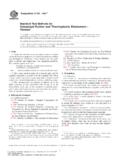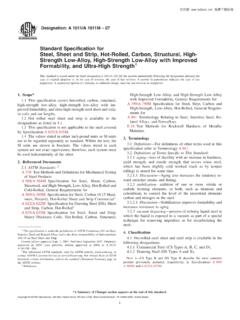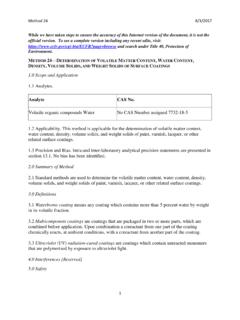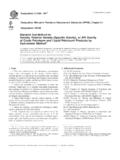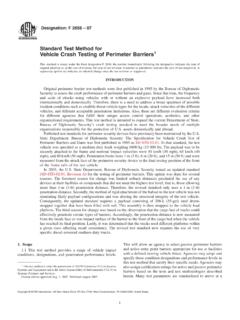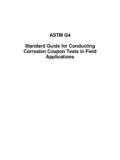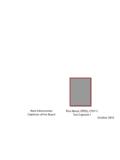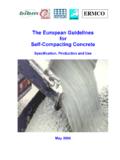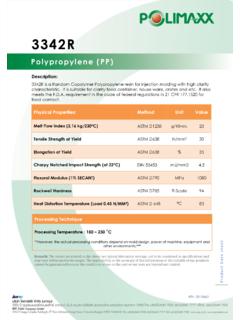Transcription of Standard Test Method for Rubber Property—Effect …
1 Designation: D 471 06 Standard Test Method forRubber property effect of liquids1 This Standard is issued under the fixed designation D 471; the number immediately following the designation indicates the year oforiginal adoption or, in the case of revision, the year of last revision. A number in parentheses indicates the year of last reapproval. Asuperscript epsilon (e) indicates an editorial change since the last revision or Standard has been approved for use by agencies of the Department of This test Method covers the required procedures toevaluate the comparative ability of Rubber and Rubber -likecompositions to withstand the effect of liquids. It is designedfor testing: (1) specimens of vulcanized Rubber cut fromstandard sheets (see PracticeD 3182), (2) specimens cut fromfabric coated with vulcanized Rubber (see Test MethodsD 751), or (3) finished articles of commerce (see PracticeD 3183).
2 This test Method is not applicable to the testing ofcellular rubbers, porous compositions, and compressed sheetpacking, except as described ASTM Oils No. 2 and No. 3, formerly used in this testmethod as Standard test liquids, are no longer commerciallyavailable and in 1993 were replaced with IRM 902 and IRM903, respectively (seeAppendix X1for details). ASTM No. 1 Oil, previously used in this test Method asa Standard test liquid, is no longer commercially available andin 2005 was replaced with IRM 901; refer toTable 1, FootnoteA, andAppendix X3for This test Method includes the following:Change in Mass (after immersion)Section10 Change in Volume (after immersion)Section11 Dimensional-Change Method for Water-Insoluble Liq-uids and Mixed LiquidsSection12 Change in Mass with Liquid on One Surface OnlySection13 Determining Mass of Soluble Matter Extracted by theLiquidSection14 Change in Tensile Strength, Elongation and Hardness(after immersion)Section15 Change in Breaking Resistance, Burst Strength, TearStrength and Adhesion for Coated FabricsSection16 Calculation (of test results) The values stated in SI units are to be regarded as thestandard.
3 The values in parentheses are for information Standard does not purport to address all of thesafety concerns, if any, associated with its use. It is theresponsibility of the user of this Standard to establish appro-priate safety and health practices and determine the applica-bility of regulatory limitations prior to Referenced Standards:2D92 Test Method for Flash and Fire Points by ClevelandOpen Cup TesterD97 Test Method for Pour Point of Petroleum ProductsD 287 Test Method for API Gravity of Crude Petroleum andPetroleum Products (Hydrometer Method )D 412 Test methods for Vulcanized Rubber and Thermo-plastic Elastomers TensionD 445 Test Method for Kinematic Viscosity of Transparentand Opaque Liquids (and Calculation of Dynamic Viscos-ity)D611 Test methods for Aniline Point and Mixed AnilinePoint of Petroleum Products and Hydrocarbon SolventsD 751 Test methods for Coated FabricsD 865 Test Method for Rubber Deterioration by Heatingin Air (Test Tube Enclosure)
4 D 975 Specification for Diesel Fuel OilsD 1217 Test Method for Density and Relative Density(Specific Gravity) of Liquids by Bingham PycnometerD 1415 Test Method for Rubber property InternationalHardnessD 1500 Test Method for ASTM Color of Petroleum Prod-ucts (ASTM Color Scale)D 1747 Test Method for Refractive Index of Viscous Mate-rialsD 2008 Test Method for Ultraviolet Absorbance and Ab-sorptivity of Petroleum ProductsD 2140 Test Method for Carbon-Type Composition of In-sulating Oils of Petroleum OriginD 2240 Test Method for Rubber property DurometerHardnessD2699 Test Method for Research Octane Number ofSpark-Ignition Engine FuelD 3182 Practice for Rubber Materials, Equipment, andProcedures for Mixing Standard Compounds and Prepar-ing Standard Vulcanized Sheets1 This test Method is under the jurisdiction of ASTM Committee D11 on Rubberand is the direct responsibility of Subcommittee on Degradation edition approved Oct.
5 1, 2006. Published November 2006. Originallyapproved in 1937. Last previous edition approved in 1998 as D 471 referenced ASTM standards, visit the ASTM website, , orcontact ASTM Customer Service at ForAnnual Book of ASTMS tandardsvolume information, refer to the Standard s Document Summary page onthe ASTM ASTM International, 100 Barr Harbor Drive, PO Box C700, West Conshohocken, PA 19428-2959, United `,,```,,,,````-`-`,,`,,`,`,,`---D 3183 Practice for Rubber Preparation of Pieces for TestPurposes from ProductsD 4483 Practice for Evaluating Precision for Test MethodStandards in the Rubber and Carbon Black ManufacturingIndustriesD 4485 Specification for Performance of Engine OilsD 4806 Specification for Denatured Fuel Ethanol for Blend-ing with Gasolines for Use as Automotive Spark-IgnitionEngine FuelE 145 Specification for Gravity-Convection And Forced-Ventilation Standards:3J 300 Engine Oil Viscosity Classification3.
6 Summary of Test This test Method provides procedures for exposing testspecimens to the influence of liquids under definite conditionsof temperature and time. The resulting deterioration is deter-mined by measuring the changes in physical properties, such asstress/strain properties, hardness, and changes in mass, volume,and dimension, before and after immersion in the test The precision statement in Section19is based on aninterlaboratory test program run in 1981, using six differentrubbers with ASTM Reference Fuels B, C, D4and ASTM OilsNo. 1 and No. The precision statement inAppendix X2is based on aninterlaboratory test program conducted in 1993 to establishreplacements for ASTM Oils No.
7 2 and No. 3. Because of thelimited number of participating laboratories, only repeatabilitycould be evaluated, and it was necessary to use pooled valuesof four No. 2 type oils (No. 2 plus three candidate replacementoils) and four No. 3 type oils (No. 3 plus three candidatereplacement oils). Twelve rubbers were tested in this ASTM Oils No. 1, No. 2, and No. 3 have been replacedby IRM 901, IRM 902, and IRM 903, Significance and Certain Rubber articles, for example, seals, gaskets,hoses, diaphragms, and sleeves, may be exposed to oils,greases, fuels, and other fluids during service. The exposuremay be continuous or intermittent and may occur over widetemperature Properties of Rubber articles deteriorate during exposureto these liquids, affecting the performance of the Rubber part,which can result in partial This test Method attempts to simulate service conditionsthrough controlled accelerated testing, but may not give anydirect correlation with actual part performance, since serviceconditions vary too widely.
8 It yields comparative data on whichto base judgment as to expected service This test Method is suitable for specification compliancetesting, quality control, referee purposes, and research anddevelopment Test and Immersion Periods Unless otherwisespecified the test temperature and immersion period shall be asindicated inTable 2, depending upon the anticipated serviceconditions, unless otherwise agreed upon between customerand When the temperature of the testing room is other thanthe Standard 2362 C (7364 F) the temperature of test shallbe from Society of Automotive Engineers (SAE), 400 CommonwealthDrive, Warrendale, PA sole source of supply of Reference Fuels A, B, C, D, and E known to thecommittee at this time is Phillips Petroleum Co.
9 , Customer Service Center, Box968, Borger, TX 79007. If you are aware of alternative suppliers, please provide thisinformation to ASTM International Headquarters. Your comments will receivecareful consideration at a meeting of the responsible technical committee,1whichyou may 1 Specifications and Typical Properties of ASTM and IRM Reference OilsPropertyASTM Oil No. 1 AASTM Oil No. 5 IRM 901 IRM 902 IRM 903 ASTM MethodSpecified Properties:Aniline Point, C ( F)12461 (25562)11561 (23962)12461 (25562)9363 (19965)7061 (15862)D611 Kinematic Viscosity(mm2/s [cSt])38 C (100 F).. 44599 C (210 F) 445 Gravity, API, 16 C(60 F).. 2140 Flash Point COC, C( F)243 (469) min243 (469) min243(469) min240 (464) min163 (325) minD92 Naphthenics,CN(%).
10 27 (avg)35 min40 minD 2140 Paraffinics,CP(%)..65 min50 max45 maxD 2140 Typical Properties:Pour Point, C ( F).. 15 (5) 12 (10) 12 (10) 31 ( 24)D97 ASTM 1500 Refractive 1747UV Absorbance, 260 2008 Aromatics,CA(%)..431214D 2140 AASTM Oil No. 1 is no longer commercially available, the specifications are left in place for the purpose of reference until such time as an interlaboratory test programis conducted to determine precision and bias. Refer toAppendix 062--`,,```,,,,````-`-`,,`,,`,`,,` When the relative humidity (RH %) of the testingenvironment is known to effect the performance of a test liquid,the RH % shall be The choice of the immersion period will depend uponthe nature of the vulcanizate, the test temperature, and theliquid to be used.

